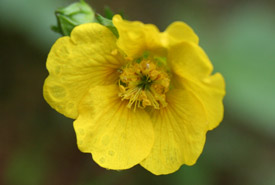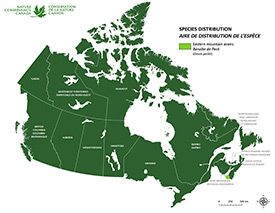
Eastern mountain avens (Photo by June Swift)
Eastern mountain avens
If you visit Brier Island in Nova Scotia, you may see a delicate plant growing at the edge of bogs and other wetland habitats. Small and fragile, and not likely well known, the eastern mountain avens is, in fact, one of the most endangered plants in Canada. The Nature Conservancy of Canada (NCC) is helping change this.
Where are eastern mountain avens found?
A member of the rose family, this yellow flower exists in only two isolated populations — along streams in the alpine meadows of the White Mountains in New Hampshire and in the coastal peatlands of Brier Island and Digby Neck, Nova Scotia. The Canadian population of eastern mountain avens represents a quarter to a third of the global population. Roughly a third of the Canadian population can be found on NCC’s property on Brier Island in southwest Nova Scotia.
What is the conservation status of this species?
Eastern mountain avens is a highly disjunct species with very limited distribution and substantial population declines in Canada. Threats to the species include habitat alteration, changes in hydrology through road maintenance and development, drainage ditches and off-highway vehicle use. Historical loss of habitat at one location was caused by the creation of a drainage ditch through a wetland, which in turn led to the succession of the wetland and nutrient enrichment by nesting gulls. In Canada, the species is listed as endangered both federally and provincially.
Facts:
- It is a perennial (meaning it lives for more than two years).
- its stalk grows 20–40 centimetres tall.
- its flowers are 1–3 centimetres long.
- It flowers from June to September.
- It likes cool, moist habitats.
- Its flowers follow the movement of the sun across the sky.
What is NCC doing to protect habitat for this species?
A partnership of conservation organizations, including NCC, has undertaken restoration work in the bog where eastern mountain avens is most populous and faces the greatest threats from habitat loss. NCC’s work has focused on outreach and engagement with the local community through communications and the distribution of interpretive materials and hands-on volunteer activities. Ongoing monitoring of the impact of the restoration continues, and the partnership is developing objectives and actions to ensure the successful recovery of this species.
The power of partnership
So, as spring returns to Brier Island and the first flowers of the eastern mountain avens unfurl, its yellow petals signal a sense of hope that this little plant will continue to survive and thrive due to the efforts of NCC, partners and our dedicated conservation staff.
To learn more read the recovery strategy for the eastern mountain avens here.





